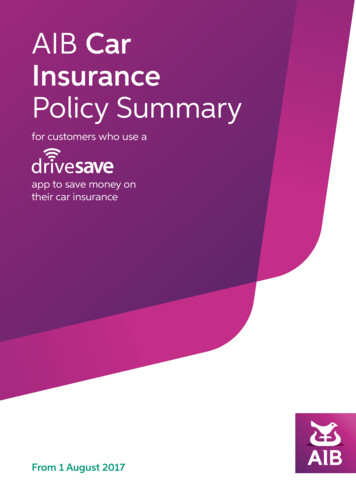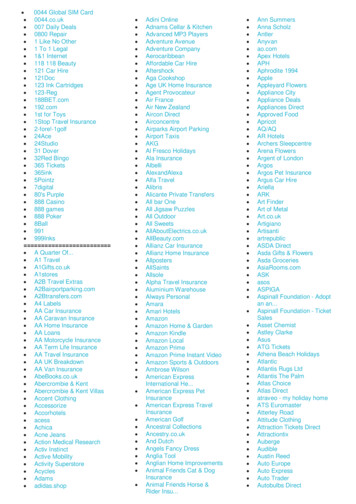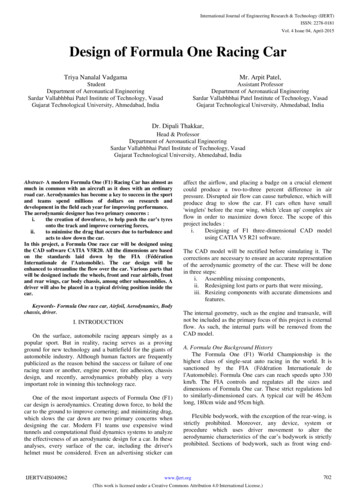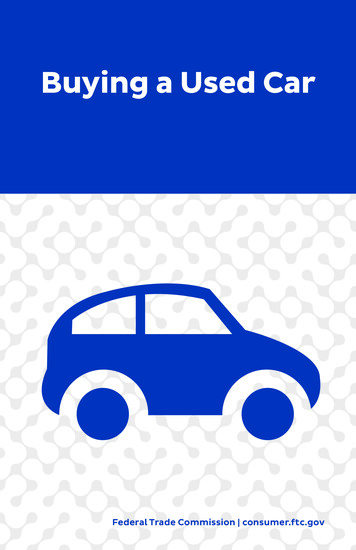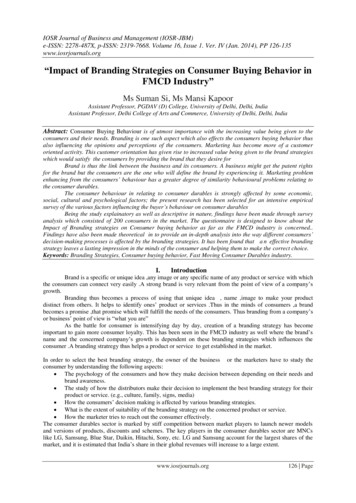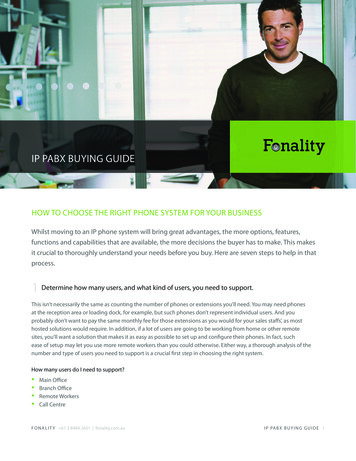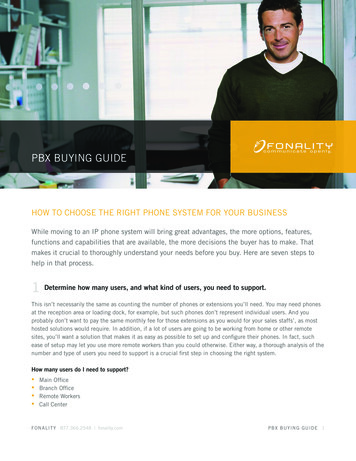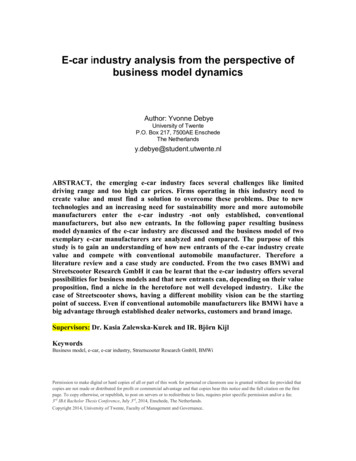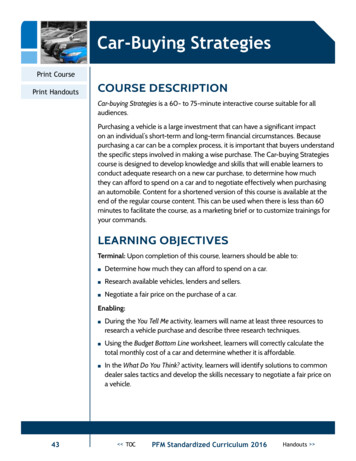
Transcription
Car-Buying StrategiesPrint CoursePrint HandoutsCOURSE DESCRIPTIONCar-buying Strategies is a 60- to 75-minute interactive course suitable for allaudiences.Purchasing a vehicle is a large investment that can have a significant impacton an individual’s short-term and long-term financial circumstances. Becausepurchasing a car can be a complex process, it is important that buyers understandthe specific steps involved in making a wise purchase. The Car-buying Strategiescourse is designed to develop knowledge and skills that will enable learners toconduct adequate research on a new car purchase, to determine how muchthey can afford to spend on a car and to negotiate effectively when purchasingan automobile. Content for a shortened version of this course is available at theend of the regular course content. This can be used when there is less than 60minutes to facilitate the course, as a marketing brief or to customize trainings foryour commands.LEARNING OBJECTIVESTerminal: Upon completion of this course, learners should be able to:O Determine how much they can afford to spend on a car.O Research available vehicles, lenders and sellers.O Negotiate a fair price on the purchase of a car.Enabling:O During the You Tell Me activity, learners will name at least three resources toresearch a vehicle purchase and describe three research techniques.O Using the Budget Bottom Line worksheet, learners will correctly calculate thetotal monthly cost of a car and determine whether it is affordable.O In the What Do You Think? activity, learners will identify solutions to commondealer sales tactics and develop the skills necessary to negotiate a fair price ona vehicle.43TOCPFM Standardized Curriculum 2016Handouts
Car-Buying StrategiesREFERENCESDepartment of the Navy. (2005). SECNAV Instruction 1754.1B: Family SupportPrograms. Office of the Secretary of the Navy, Washington, D.C.Department of the Navy. (2010). OPNAV Instruction 1740.5B Change Transmittal2, United States Navy Personal Financial Management (PFM) Education, Training,and Counseling Program. Chief of Naval Operations, Washington, D.C.Department of the Navy. (2009). Command Financial Specialist Training Manual.Commander, Navy Installations Command, Washington, D.C.“2013 Hybrid/Electric Buying Guide.” Edmunds.com. Edmunds.com Inc., n.d. Web.Dec. 22, 2015. ml“About Us.” CARFAX. CARFAX Inc., 2014. Web. May 13, 2014. http://www.carfax.com/about/car history/hcabout.cfm“How to Negotiate a New Car’s Price: Terms to be Familiar With When Shoppingfor a Car.” Consumer Reports.org. Consumer Reports, March 2014. Web. May12, 2014. icing-terms/index.htmBurnette, Margarette. “7 Automakers with the Best Car Warranties.” Bankrate.com.Bankrate Inc., n.d. Web. May 14, 2014. st-car-warranties-1.aspx“Buying a Car.” Practical Money Skills for Life. Visa, n.d. Web. May 12, 2014. e/lifeevents/car/“Car-Buying Terms Glossary: Making Sense of Dealer-Speak.” Car and Driver.Hearst Communications Inc., March 2010. Web. May 12, 2014. ms-glossary-buyers-infoGreen Vehicle Guide. U.S. Environmental Protection Agency, n.d. Web. May 14, y, Amanda C. “5 of the Best Auto Warranties.” Investopedia. Investopedia US,February 1, 2013. Web. May 13, 2014. f-the-best-auto-warranties.aspx“Keys to Vehicle Leasing.” Board of Governors of the Federal Reserve System, n.d.Web. May 22, 2014. M Standardized Curriculum 2016Handouts
Car-Buying StrategiesNewman, Rick. “6 Myths About Car Recalls: They’re More Common and LessRuinous Than the Toyota Hype Suggests.” US News & World Report. U.S. News &World Report LP, February 10, 2010. Web. May 13, 2014. /02/10/6-myths-about-car-recallsReed, Phillip. “10 Steps to Finding the Right Car for You.” Edmunds.com. Edmunds.com Inc., February 4, 2014. Web. May 12, 2014. ng-the-right-car-for-you.htmlReed, Phillip. “10 Steps to Leasing a New Car.” Edmunds.com. Edmunds.com Inc.,April 11, 2014. Web. May 14, 2014. ing-a-new-car.htmlReed, Phillip. “True Cost to Own (TCO).” Edmunds.com. Edmunds.com Inc., May 12,2011. Web. May 14, 2014. tco.html“Terminating Your Lease Due to Deployment or PCS.” Military OneSource.Department of Defense, May 9, 2013. Web. May 15, 2014. http://www.militaryonesource.mil/pfm?content id 269402“What is the Average Car Depreciation Rate?” CarsDirect. Internet BrandsInc., November 8, 2013. Web. May 12, 2014. verage-car-depreciation-rate“What is 5-Year Cost to Own?” Kelley Blue Book. Kelley Blue Book Co.Inc., n.d. Web. May 14, 2014. p/?r 494167664772180350COURSE PREPARATIONHandouts:O The Budget Bottom LineO Car-buying Sources of HelpO Car Sales Tricks of the TradeO Common Dealership Financing PitfallsO Debt-to-income RatioO Determining Car PaymentsO Financial Planning WorksheetO Installment Sale Contract for Titled Vehicle and Equipment45TOCPFM Standardized Curriculum 2016Handouts
Car-Buying StrategiesO Leasing vs. BuyingO Questions to Ask Car DealersO Three Deals of Car-buyingO You Tell MeMaterials (vary depending on activities chosen):O Chart paper or whiteboard and markersO Pens, pencils, paperO CalculatorsO Car-buying Strategies PowerPoint slidesO Car-buying Jackpot PowerPoint gameO Internet access (optional)SUMMARY OF LEARNER ACTIVITIESO You Tell Me: An interactive exercise in which learners list everything they knowabout a car-buying topic and the instructor provides the missing content.O The Budget Bottom Line: A worksheet activity in which learners calculate theaffordability and total monthly cost of a vehicle.O What Do You Think? A discussion-based activity for learners to examine dealertactics and develop negotiating skills.O Car-buying Jackpot: An optional PowerPoint game-show-style presentation ofcourse content that can be used in lieu of lecture or as a course review.CONTENT OUTLINE1. Welcome and Introduction (10 minutes)a. Agenda and Topic Overviewb. Learner Activity: You Tell Me2. Deal No. 1: The Purchase (25 minutes)a. Know What You Can Affordi. Preparing a Spending Planii. Credit Concernsiii. Determining Car Payments46TOCPFM Standardized Curriculum 2016Handouts
Car-Buying Strategiesb.c.d.e.iv. Learner Activity: The Budget Bottom LineChoosing Your Cari. Insuranceii. Performance and Reliabilityiii. Where Will You Buy?Determining a Fair Pricei. Where to Find Pricing Informationii. Fair Pricing TerminologyWhat About Leasing?Negotiationi. Negotiation Tacticsii. Learner Activity: What Do You Think?iii. Negotiation Strategies3. Deal No. 2: The Financing (10 minutes)a. Where to Financeb. Finance Chargesc. Contracts4. Deal No. 3: The Trade-In (5 minutes)5. Know Your Rights (5 minutes)a. Your Legal Rightsb. Complaint Resolution6. Summary (5-20 minutes)a. Sources of Helpb. Optional Learner Activity: Car-buying JackpotCONTENT MATERIALWELCOME AND INTRODUCTIONAgenda and Topic Ov erviewSLIDE 147Most service members will purchase a new or used car while on active duty. Theywill spend more of their disposable income on automobiles than on virtuallyanything else except food and shelter. This course explores how service membersand their family members can save hundreds, if not thousands, of dollars on theirnext vehicle purchase.TOCPFM Standardized Curriculum 2016Handouts
Car-Buying StrategiesTrainer’s note: Refer learners to The Three Deals of Car Buying and Car-Buying Sourcesof Help handouts.SLIDE 2Most Americans will purchase a vehicle at some point in their lives. Although itcan be exciting to dream and plan for buying a car, there are many opportunitiesto make unwise choices if you do not learn about the process before you buy. Thiscourse is designed to help you save money and hassles on your next car purchaseby focusing on the Three Deals of Car Buying — the Purchase, the Financing andthe Trade-in. It will also take a look at the legal rights you have when buying orselling a car, and the sources of help available to inform and guide you in thisimportant decision.LEARNER ACTIVITY: You Tell MeTime: Eight minutesMaterials: You Tell Me handoutProcedure: For a small class, this can be done as a whole-group activity. For largeclasses, divide the class into smaller groups for optimum participation. Distributethe You Tell Me handout and explain to the class that because car buying is sucha popular topic, you would like to get their input on some aspects of buying a car.(Note: You will find that most people have at least some knowledge of car buying,and getting their input at the beginning of the class will help engage learners inactively participating and sharing.)DEAL NO. 1: THE PURCHASESLIDE 3Many people begin the car-buying process by visiting a dealership, which shouldbe one of the last things they do. Unfortunately, the process often ends the sameday with the purchase of an inappropriate car at too high a price. Dealers will askabout financing and trade-ins before offering a bottom-line price so that they canmentally calculate their profit to the buyer’s disadvantage. You can save yourselfhundreds, if not thousands, of dollars on your next purchase by doing somehomework before you step onto the lot so that you are always in control of thebuying process.To make a successful purchase, there are four things you need to determine before stepping onto the lot. They are:1. How much you can afford.2. The type of vehicle you want to buy.48TOCPFM Standardized Curriculum 2016Handouts
Car-Buying Strategies3. Where you will buy the vehicle.4. A fair and affordable price for the vehicle.Trainer’s note: Use the lists generated during the You Tell Me activity for examples anddiscussion points during the instruction on these four points.Know What You Can AffordBefore you shop, know how much you can afford to spend each month for thecar and its upkeep. To save yourself a lot of money, time and effort, do yourhomework first to determine what you can realistically spend on a new car. Consider the following:SLIDE 4How much you can spend in total on the vehicle? If you only figure out howmuch you can afford to pay each month and not the total amount you want tospend on the vehicle, you will probably get the monthly payment you want butrisk paying too much for the vehicle overall.How much you can put down on the vehicle? The greater the down payment,the less you have to finance and the lower your monthly payment.How much can you spend per month on a payment? If you only figure howmuch you want to pay in total, you risk ending up with a monthly payment thatyou will not be able to afford. Buy the car; never buy the payments.Preparing a Spending PlanTrainer’s note: Refer learners to the Financial Planning Worksheet. Encourage them tocomplete their budget or spending plan if they do not already have one. Invite them toattend a Developing Your Spending Plan class or to visit their Command Financial Specialist(CFS) or Fleet and Family Support Center (FFSC) financial counselor for help in creating aspending plan.SLIDE 549How much you can afford to spend monthly, on a down payment and for totalmonthly costs and maintenance, can be found in your budget or spending plan.If you already use a budget at home, review it and determine what you can affordto spend on your new car. We will go over ideas that will help in this course. If youdo not already have a spending plan, now is a great time to start. The benefits ofhaving a budget or spending plan can extend far beyond this car purchase andcan affect your entire financial future. Developing a budget or spending plan inadvance of a car purchase is a win-win situation!TOCPFM Standardized Curriculum 2016Handouts
Car-Buying StrategiesCredit ConcernsTrainer’s note: Refer learners to the Debt-to-income Ratio worksheet and explain howit works. If they have had issues or concerns about their debt, invite them to attend aCredit Management workshop or visit their CFS before they buy a car. Encourage learnersto review their credit report as one of the first steps they take in buying a car.Debt-to-income ratio: You will also want to know how much of your moneycurrently goes to pay regular monthly debt payments so you do not overextendyourself if you add a car payment. To find this out, compute your debt-to-incomeratio. The debt-to-income ratio is a figure used to determine whether a personis carrying a total debt load that is manageable, one that might lead to financialdifficulties, or one that indicates a person is in immediate need of debt reductionand significant adjustments in their financial lifestyle. Use it as a guide, not as anabsolute measure of your ability to take on more debt.Use the scale at the bottom of the page to determine whether you have room inyour budget to take on more debt. If your debt-to-income ratio is 20 percent orhigher, you may want to hold off on taking on more debt.Your credit report: Be sure to check your credit report as you work on yourspending plan and debt-to-income ratio. A dealership will pull your report, soit is best you look at it first, unless you are paying in cash or have pre-approvedfinancing. This way, there will be no surprises. Information on how to get your freeannual credit report is included in the Car-buying Sources of Help handout.Pre-approved loan: Consider getting pre-approved for a loan from your financialinstitution. This will provide information on interest rates, payments and terms inaddition to ensuring you do not overextend yourself once at the dealership.Determining Car PaymentsTrainer’s note: Refer learners to the Determining Car Payments handout and ensurethey understand how to make the calculations. Explain that most credit union, bank andcar-buying websites also have calculators that help you determine what a car paymentwill be based on the amount of the loan, the number of months and the annual percentage rate.If you need some help to determine how much a payment would be for a specificloan amount, you can use the Determining Car Payments handout. The websitesreferred to on your Car-Buying Sources of Help handout also offer calculators toassist you.50TOCPFM Standardized Curriculum 2016Handouts
Car-Buying StrategiesWhat is a reasonable monthly car payment? Financial advisers usually suggestkeeping total car expenses to within 25 percent of your net income (what remainsafter taxes). Total car expenses include the car loan payment as well as maintenance, insurance, operating expenses (e.g., fuel, oil), taxes, license and registration.These operating expenses can sometimes total up to one-third of the monthlypayment. To avoid spending more than you can afford, multiply the amount youfigure you can afford to spend each month on your new vehicle (the total cost) by.66. The sum will give you a good idea of what the maximum car loan payment isfor your current financial situation.LEARNER ACTIVITY: The Budget Bottom LineTime: 10 minutesMaterials: The Budget Bottom Line worksheetsProcedure: Distribute worksheets to the class. The facilitator can decide whetherthis will be done as an individual activity, in pairs or as small groups. Explain to theclass that they will be calculating the budget “bottom line” to determine whetherthe cost of the vehicle payment and expenses are affordable (i.e., will they fit intothe budget without creating a budget deficit?). You can read the opening scenarioto the class or ask for a volunteer to read it.Part I: Instruct the class to use the information from the scenario, and the budgetinformation provided, to calculate the suggested maximum affordable car payment; they should determine the budget bottom line. Give the class about fiveminutes to complete the calculations and then go over their answers.Answers: 2,536 x .25 634 634 x .66 418.44 2,536 - 1,845 691According to these calculations, the couple has 691 left over each month andtherefore can afford both the maximum payment based on net income and theamount the couple estimated for their chosen vehicle.Part 2: (Optional)Ask the class to consider whether their decisions would be different if they knewthat although the couple’s budget showed a budget surplus sufficient to purchase51TOCPFM Standardized Curriculum 2016Handouts
Car-Buying Strategiesthe car, they had a 35 percent debt-to-income ratio? This can be a good way toreinforce the information provided on credit issues before the activity.Choosing your CarThe vehicle you purchase must strike the right balance between wants, needsand affordability. Everyone has different preferences in a vehicle. There are manyfactors to consider when deciding what to get, including size; manual or automatictransmission; two-, four- or all-wheel drive; use (on or off-road, length of commute, parking conditions); style; safety; ownership and operating costs.SLIDE 6To help you determine what type of car is right for you, ask yourself the followingquestions:O How many passengers do you typically carry?O Do any passengers need help getting in and out of the vehicle?O Will you be transporting children and need accessibility for car seats?O How many miles will you be putting on your car annually?O How long is your daily commute?O Are you looking for a specific fuel economy or to buy a “green” vehicle?O Are there specific features you need on your car?O What safety features are important to you?O Do you have children? What are their ages?O Do you need cargo space, towing capacity or all-wheel drive?Once you have made some choices as far as the type and style of the car youneed, you have another choice that can significantly affect the price — should youget a new car or a used car? Each one has positive and negative aspects; there areno absolute answers to the question of a new versus used car. Each buyer mustconsider his or her own needs and resources when making the choice.New car considerations:O Cost: Almost always more than a used car.O Mechanical problems: Likely to have fewer than a used car.O Depreciation: The value of a new car diminishes rapidly following the purchase,anywhere from 15 percent to 20 percent in the first year. To get the full value ofa new car, many consumers plan to own it for four, five or more years.52TOCPFM Standardized Curriculum 2016Handouts
Car-Buying StrategiesO Warranties: The average new car warranty is three years or 36,000 miles,although some automakers have warranties up to five years or 60,000 miles.Extended warranties can be purchased at extra cost.Used car considerations:O Cost: Generally less than a new car.O Mechanical problems: Likely to have more than a new car. Repair costs canadd significant amounts to the cost of owning and operating a car. Are youmechanically inclined and able to make your own repairs? Do you have an automechanic you know and trust? Have you considered using base auto hobbyshops?O Depreciation: Usually less than a new car because much of it may have alreadyoccurred.O Warranties: May or may not have any remaining. Service contracts will addsignificantly to the cost of the car.InsuranceTrainer’s note: Gap insurance can provide valuable protection during the early yearsSLIDE 7of your car’s life if you have a loan or a lease. If a loss occurs, gap insurance will pay thedifference between the actual cash value of the vehicle and the outstanding balance onthe vehicle within or based on certain limitations according to the provisions of the loan.Sometimes it will also pay your regular insurance deductible. Remember, however, thateach loan and insurance policy differs, so it is important for learners to check the provisions of each for exclusions and coverage.Once you have narrowed your choices to a few models, compare quotes on insurance costs. Sometimes two similar vehicles can have different insurance costs,and that cost difference will help you make a final decision on a model. Moreover,knowing the cost ahead of time enables you to figure this significant expense intothe budget. For many junior service members, the insurance payment can be asmuch or more than the car payment.Tips for cutting your car insurance costs include:O Shop around. Get at least three rate quotes. Insurance quotes should be obtained before you sign on the dotted line.O Remember that safety features such as anti-lock brakes, airbags, daytimerunning lights and security systems can sometimes merit discounts on yourinsurance policy.53TOCPFM Standardized Curriculum 2016Handouts
Car-Buying StrategiesO Take a higher deductible to get a lower premium (but make sure you have thesavings to cover the deductible).O Review your policy and drop options or coverage that you no longer need onan older vehicle.O Check your credit report. Insurance companies now check your credit worthiness before issuing a new policy or renewing a current insurance policy. Ifyou have credit problems, it can affect the cost of your insurance or even yourability to get insurance.O Ask for discounts: low mileage, group, military, good student, etc.O Avoid lapses in coverage.O Be a safe driver. A poor driving record can increase premiums.O Pay the premium up front, if possible, because there may be a fee associatedwith an installment plan.O If leasing, read the lease to see whether gap insurance is required. If so, shoparound for the best deal. If gap insurance is required, you usually have to havecollision and comprehensive coverage as well. Note that insurance will be significantly higher on a leased vehicle because you do not actually own it.Performance and ReliabilitySLIDE 8Too many consumers choose their car by the image it portrays. Your goal shouldbe to choose the safest, most reliable and best-performing car for the price youcan afford. One of the concerns of car ownership is the cost of maintaining anddriving your chosen vehicle. A car may be reasonably priced, but if it is known tobe costly to maintain or drive, you may find it costs more than you can afford.To find out more about the performance and reliability of the vehicles you areconsidering, you might want to check these resources.Consumer Reports: Consumer Reports rates the reliability, safety, performance andfuel economy of cars and is relatively unbiased because it accepts no advertising.CARFAX vehicle history report: CARFAX reports contain information that can affect a consumer’s decision about a used vehicle. Some types of information that aCARFAX report includes are:O Title information, including salvaged or junked titlesO Flood damage historyO Total loss accident history54TOCPFM Standardized Curriculum 2016Handouts
Car-Buying StrategiesO Odometer readingsO Lemon historyO Number of ownersO Accident indicators, such as airbag deploymentsO State emissions inspection resultsO Service recordsO Vehicle use (taxi, rental, lease, etc.)Source: CARFAX.comKeep in mind, however, that if body shop repairs or maintenance was performedby a private individual or by the owner of the vehicle, this information will not usually show up on a CARFAX report. So even with a CARFAX report, it is still a goodidea to have a used vehicle inspected by a mechanic or someone knowledgeableabout vehicles before committing to that vehicle.Other sources: You can also consult Consumers Union publications and the Insurance Institute for Highway Safety. There are many websites that examine the costand performance issues of vehicles listed on your Car-Buying Sources of Help handout.Fuel economy: With fluctuating gas prices, fuel economy plays a part in theaffordability of your chosen vehicle. If you have a long commute or plan to makea lot of long trips annually, fuel costs could affect your choices when purchasinga car. To check or compare fuel economy, go to the U.S. Department of Energy’sfuel economy website, http://www.fueleconomy.gov/. Additionally, there are specific options on a car that can affect fuel economy. Consider choosing the smallestengine possible for your chosen vehicle (i.e., four-cylinder instead of six-cylinder)or going with a manual transmission to increase fuel efficiency. The last thing youwant is to discover after you purchase a car that you cannot afford to drive it.Going “green”: You may be interested in a fuel-efficient vehicle as a way to reducefuel costs or in an effort to protect our environment. Options include hybrids,electric and alternative-fuel vehicles. Most hybrids offer a relatively simple combination of gas and electric power without any additional equipment needed tooperate, while electric and alternative-fuel vehicles require access to fuel sources(i.e., charging or refueling stations, special fuel, etc.). There are some tax incentivesfor purchasing green vehicles, and some states offer specific incentives for individuals who drive green vehicles. Remember that you will typically pay more for55TOCPFM Standardized Curriculum 2016Handouts
Car-Buying Strategiesgreen vehicles, so be sure to do your homework on the different types and howeach functions. You can consult the U.S. Environmental Protection Agency’s website on green vehicles for more information s: Millions of cars and trucks are recalled annually. Most recalls do not posean immediate safety risk, but sometimes recalls involve problems that, althoughrare, could lead to serious safety issues. Research your prospective vehicle thoroughly to see whether there have been recalls on that particular make and model.You also should verify whether the seller or dealership has properly repaired orreplaced the defective items.True cost of ownership: To figure out the overall cost of driving and maintainingyour chosen vehicle, you may want to consult a true cost of ownership calculator.Edmunds.com has an online calculator that considers the hidden costs of carownership. You can try out this calculator at http://www.edmunds.com/tco.html.Where will you buy?Dealerships: Car buyers should research a minimum of three potential sellers.There are no absolute guidelines to follow in selecting a dealer, a salesperson oran individual from whom to buy a car. Do your homework and you should get agood deal no matter from whom you buy. Since buying a new car likely involveschoosing a dealership, here are some guidelines to use.SLIDE 9O Years in business: Although being in business for a long time does not necessarily mean that the dealer is honest and reliable, the worst of the dealers (interms of how buyers are treated) seem to go out of business fairly quickly.O Complaints: Check with the Armed Forces Disciplinary Control Board, a state’soffice of consumer affairs, the Better Business Bureau and any professionalassociations to which the dealer belongs for any complaints filed against them.O Salespersons and mechanics: How long have they been with the company?Again, not a foolproof factor, but anything that suggests company stabilityis frequently a good sign. Take your salesperson for a “test drive”— Are theypushy? Relaxed? Open? Impatient? Responsive? Make sure the salesperson issomeone you can work with.O References: These are sometimes used to impress the buyer, but unless youcan get a complete list of everyone who has ever bought a car from the seller,assume the seller is giving you the names of persons who will only say positivethings. In other words, skip checking their references.56TOCPFM Standardized Curriculum 2016Handouts
Car-Buying StrategiesO Professional membership: Membership in the Better Business Bureau, NationalAutomobile Dealers Association or National Independent Automobile DealersAssociation does not automatically mean a good deal for you. It does, however,give you some reassurance that there are avenues for you to address concernsif they occur.Private sellers: Frequently, car buyers can save money by purchasing from aprivate seller. The downside is that there is little or no consumer protection afterthe sale and no repair plan. If the car purchaser truly is knowledgeable about carsor can bring along someone who has that knowledge, this may be an excellentsource to consider.Although most of us want to trust others, please consider your personal safetywhen conducting transactions with a private seller. Be cautious of the personaland financial information you disclose, and take along a friend or family memberwhen test driving or viewing the vehicle. It is also a good idea to arrange to meetat public locations that are highly visible, preferably during daylight hours.Internet: Many people are conducting successful searches for new vehicles overthe Internet. There is a wealth of research available to help you make wise consumer choices. Online car-buying sources include:O Direct services: They will sell you the car and deliver it to your house.O Referral: Your quote is given to a “preferred” dealer who contacts you.O Auctions: You name your price, and dealers bid for your business. This includese-Bay and Craigslist auctions.O Online dealerships: You browse car lots via the Internet and buy online.With online sources you may have a greater selection to choose from, but be sureto do your homework with online sources just as you would with a dealership or aprivate seller. Avoid giving out any information before you have verified that theonline source is legitimate and the site is secure.Buying services: Some organizations offer their members buying services, inwhich the consumer indicates the make, model, year and exact options they wantand the organization does the shopping for them.
48 Car-Buying Strategies TOC PFM Standardized Curriculum 2016 Handouts Trainer’s note: Refer learners to The Three Deals of Car Buying and Car-Buying Sources of Help handouts. Most Americans will purchase a vehicle at some point in their lives. Although it can be exciting to dream and plan for buying
